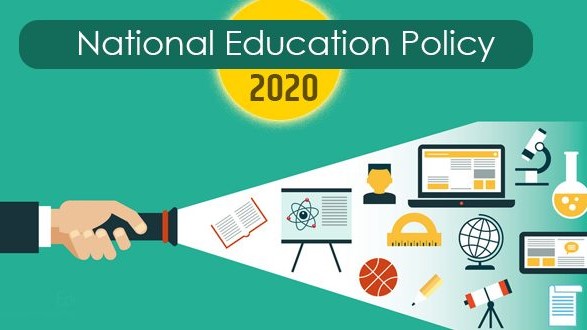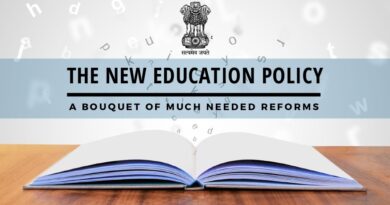INDIA – NATIONAL EDUCATION POLICY 2020 – the breakdown of 10+2 to 5+3+3+4 system of school education
To begin with, the actual number of years remain the same and this does not mean additional years. It can be perhaps looked at at play school, nursery or kindergarten classes combined with classes 1 and 2. Here’s a look at the new pedagogical structure proposed in comparison to the existing one.
Today, a student (in most urban cities) enters formal education at the age of 3 by means of play schools. Then he/she moves to a ‘school’ which is a K12 institution – Kindergarten 1 and 2 and 12 years of secondary and higher secondary education. The new structure now proposes dividing the same structure into cognitive developmental stages of the child – early childhood, school years, and secondary stage. The 5+3+3+4 structure corresponds to the following:
- Foundational Stage: For ages 3 to 8 years, the foundational stage has been suggested. The multi-level play activity based learning would include 3 years at anganwadi’s, pre-school or as commonly called play schools and the kindergarten classes catering to ages 3 to 6. To this, the grades 1 and 2 or classes 1 and 2 for students of ages 6 to 8 would also be added, keeping the focus on development of language skills and teaching by play based and activity based curriculum.
- Preparatory Stage: This is for ages 8 to 11 or classes 3 to 5. The focus would shift to play, discovery and activity based and interaction classroom learning. The focus till this stage would remain on development of language and numeracy skills, in accordance with the cognitive development of a child. Medium of instruction till Grade 5 would be home language or mother tongue or local language. Three languages would be taught to all students – and states would decide which ones.
- Middle Stage: Referring to the classes 6 to 8, the new structure aims at transforming the pedagogy from the existing system to a more experiential learning in the sciences, mathematics, arts, social sciences and humanities. Focus would be on critical learning objectives and not on rote learning.
- Secondary Stage: This includes classes 9 to 12 or the secondary and the higher secondary as we know them today. The changes suggested at this stage include a multidisciplinary study where students would be able to pick and choose any set of subjects from the available structure. The focus would be on greater critical thinking and flexibility, allowing the child to pick subjects as per their interests – even technical and arts.
Comparison between Current Education and New Education Policy
| Current Education Policy | New Education Policy |
| India currently spends 3.84% of its GDP on education | Education sector to get 6% of India’s total GDP in the coming years |
| India’s Gross Enrollment Ratio for the year 2018-19 is 26.3% | The education ministry targets to get that ration to 50% by 2035 |
| India’s current schooling structure is 10+2 | NEP is going to change that structure to 5+3+3+4 |
| The current Bachelor’s programme in India is 3 years and the Master’s programme is 2 yars | The NEP will integrate this into a 5 year Bachelor’s/ Master’s Programme and discontinue Mphil |
| Currently. Separate entrance tests are help for admission into institutions for higher education | The NTA will conduct entrance examinations for admissions to universities across the country, similar to the SATs in the USA |
| The medium of instruction in schools currently depends on school administrations | The medium of instruction until at least Grade 5, but preferably till Grade 8 and beyond, will be the home language/ mother-tongue/ local language/ regional language. |
| Vocational courses are available in certain colleges after schooling should students choose to enrol | By 2025, at least 50% of learners through the school and higher education system shall have exposure to vocational education |
| Subjects like Arts and Humanities were found as options in general colleges should students choose to enrol in them | Engineering institutions like IITs will move towards more holistic and multidisciplinary education with more Arts and humanities |
| Coding is introduced after 10th grade, depending on the educational board and syllabus it follows | Students will be allowed to take up coding from the 6th grade |
National Education Policy 2020 – 16 Highlighted Points
1. The breakdown of the 10+2 to 5+3+3+4 system of school education. Upto 5 pre school, 6 to 8 Mid School, 8 to 11 High School , 12 onwards Graduation
2. Any Degree will be 4 years
3. 6th std onwards vocational courses available. From 8th to 11 students can choose subjects
4. All graduation course will have major and minor
Example – science students can have Physics as Major and Music as minor also. Any combination he can choose
5. All higher education will be governed by only one authority.
6. UGC AICTE will be merged.
7. All University government, private, Open, Deemed, Vocational etc will have the same grading and other rules.
8. New Teacher Training board will be setup for all kinds of teachers in country, no state can change
9. Same level of Accreditation to any college, based on its rating, college will get autonomous rights and funds.
10. New Basic learning program will be created by government for parents to teach children upto 3 years in home and for preschool 3 to 6
11. Multiple entry and exit from any course
12. Credit system for graduation for each year student will get some credits which they can utilize if they take break in course and come back again to complete course
13. All schools exams will be semester wise twice a year
14. The syllabus will be reduced to core knowledge of any subject only. More focus on student practical and application knowledge
15. For any graduation course if a student completes only one year he will get a basic certificate, if he completes two years then he will get a Diploma certificate and if he completes the full course then he will get a degree certificate. So no year of any student will be wasted if they break the course in between.
16. All the graduation course feed of all Universities will be governed by single authority with capping on each course.
Source:https://www.timesnownews.com


